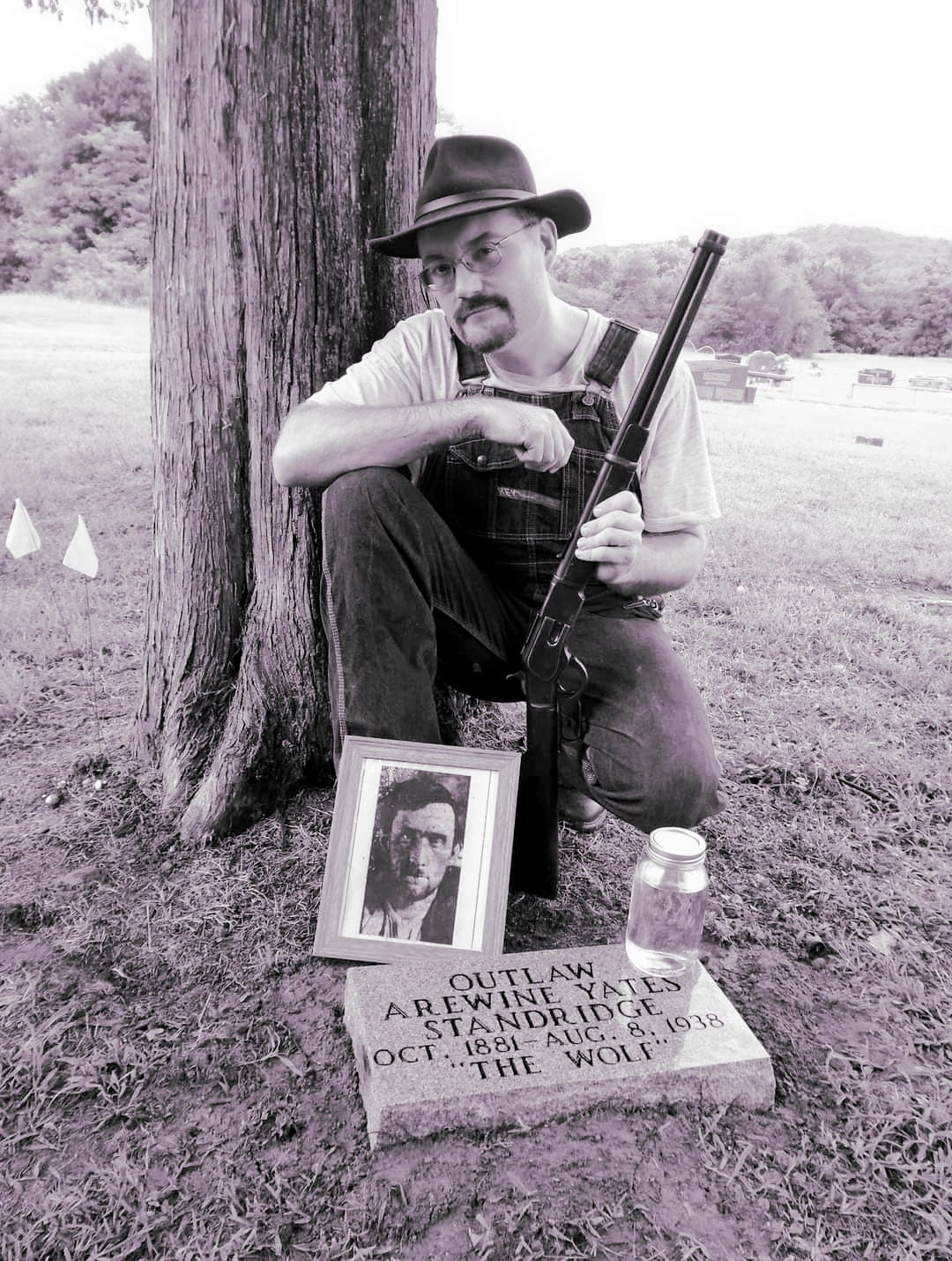‘Yates Standridge, who recently escaped from the state convict farm, where he was serving what practically amounts to a life sentence for murder, declared that he never will return to the penitentiary, according to residents of the sparsley settled hills of Newton County, where Standridge makes his home. These hill people say Standridge recently spent two weeks in that section and left, saying that he was going to Oklahoma. There is no way of verifying the truth of this. These people, who know Standridge intimately, and some whom sympathize with him, say there is no doubt that the fugitive means what he says and that the man who goes in pursuit of him will take his life in his hands. Standridge has the reputation of being a crack shot, he knows every foot of the Newton County hills and those who talked with him while he was home declare he is in a desperate mood, ready to kill on sight anyone whom he suspects has designs of recapturing him. Those who are familiar with the situation are not disposed to criticize the Newton County officers for not attempting to capture Standridge. They say it would require a large posse and many days to run down the fugitive, for he knows a hundred hiding places in the hills. Also he has many friends in the country where he lived before he was sent to the penitentiary. Many of them honestly believe that Standridge received too severe a sentence and that he has been ill-treated at the penitentiary. They would not hesitate to help him. “If those people in charge of the penitentiary haven’t sense enough to keep Standridge after they get him, I don’t know why I should go out and get killed trying to get him back for them again, ” is the way one officer sizes up the situation.’
– The Mountain Wave, Aug 25, 1916
My home county, Newton County, Arkansas, has always been the home of outlaws.
Whether they be real or imaginary, they ride through our dreams. Hard men, who defied the norms of society and sometimes even human decency. From Joe Vaughn, who claimed to be Frank James, up at Wayton, to the legend of Bonnie and Clyde stopping for fuel and rest at a Ponca fuel station, the rugged hills have drawn them. Most all these stories are unverifiable, and locals often winked at each other as the shared stories on the square with outsiders (or ‘furriners’ as we often heard them referred to), loved to see the legends grow as the outsiders headed back home and told a story of feuding clans who would brawl over the slightest slip and illicit distillers who killed to protect their stills secret.
But sometimes, truth is stranger than fiction. Arewine Yates Standridge was born in the wilds of Richland, in Newton County, Arkansas, in either October of 1874 or 1881, depending on which version you like best. He was the only son of Alexander ‘Little Alex’ and Sarah Jane (Yates) Standridge. Not a lot is known of the young life of the man who would become known as ‘the Wolf’, but it’s fair to assume he had a reasonably tame and normal childhood. Growing up in the late 1800s and early 1900s, he at some point came across one local way to make a little money: namely, making whiskey in the backwoods.
It’s not known how or when he came into contact with this business, but he had several family members in the industry as it was, and one of them likely took him in and began showing him the ropes. But Yates was on the path to a much darker future. This short essay cannot explain (nor can anything) the entire scope of his life, or why he did the things he did, but is a general overview of a local outlaw that so few have ever even heard of.
In 1906 he was indicted for assault with intent to kill John Halley. He also had other assault charges filed from 1906-1908. Yates was quickly becoming a known man to law enforcement, and his reputation as a vicious and ruthless ol’ boy was gaining notoriety.
The local law was definitely nervous about apprehending him, especially after he nearly killed Sheriff Hatley in an arrest, grazing his shoulder.
The most controversial event in Yates’s life was likely the Rosamond shooting, and the stories vary so widely that they deserve their own article, but the fact is this: Yates came to retrieve his wife, Divena Mae (Dixon) Standridge from the Rosamond home on Richland on January 1, 1908. There are two stories as to how she ended up there: one was that she fled to Justice of the Peace N. N. Rosamond’s home out of fear of her husband, which is plausible. The other is that N. N. Rosamond had taken Divena and held her against her will to draw Yates in so he could arrest a wanted man. Some stories even have a ‘Lady Savage’ who they used to tell Yates where his wife was, and went as far as to say they had her ‘chained to the floor’ and that he had to go rescue her. Whatever the case, Yates made it to the Rosamond home on that fateful day and after being denied entry, fired through the door, killing N. N. Rosamond and Martha Overturf (I’ve never found much proof of her, but have seen her listed as killed on some online writings), as well as wounding Rosamond’s wife in the arm so severely that she later lost it.
As a result of this, Yates was later captured and sentenced to 52 years in the pen. He then became known as an escape artist, escaping the prison in 1912, twice in 1916, and again in 1918. This may have been around the time he became known as ‘the human wolf’ of simply ‘the wolf’, as he had a knack for reaching the Newton County hills and disappearing without a trace. He broke prison and local jails several times in his life, and his notoriety continued to grow. After his last escape in 1920, in which he nearly froze to death escaping, he became a model prisoner and was paroled in March of 1922, with two sponsors from Newton County (names unknown).
On April 2, 1927, Yates was seriously wounded in a shootout near the Harrison square in Boone County, in which H. H. ‘Red’ Campbell was shot and killed. The shooting was allegedly over ownership of a large barrel of whiskey found nearby.
It’s not clear if Yates was charged with this murder, or got a self defense plea, but by 1930 he was living in Oklahoma. He was shot and killed along with his niece, Ada Johnson, in an ambush on August 8, 1938.
His body was returned and buried in Johnson County, Arkansas, alongside his mother.
I placed a grave marker for this man, not to glorify the wrong that he had done, and not in remembrance for the lives he took when he should not have, but for the simple fact that he deserves to be remembered, as does every man. He was notorious, ruthless, and an out and out outlaw, yet there are people who have stated he was a great neighbor who tolerated no foolishness, and that he wasn’t always the big bad villain he was made out to be.
As for me, my small contribution to his story is thus: I recently placed a marker for him in the Coal Hill Cemetery in Johnson County to commemorate his life. My wife and our newborn son, Lewis, were along for the ride. I wasn’t sure what to feel when I placed it. I knew it would create a storm of emotions, but I was still proud to be able to do a small gesture for a man who seemed forgotten, but who was once the biggest celebrity in the area, for weal or woe.
One last twist that makes me the fool, here in Yates’s story: After I read his obituary that states he is in ‘Coal Hill Cemetery’ (where I placed the marker), it turns out that he is actually buried in Hartman Cemetery down the road! The irony was that I was putting a marker up in Hartman for a family friend immediately before moving on to Coal Hill to put up Yates’!
Guess ‘the Wolf’ fooled one more ol’ boy looking for him – over 80 years after his death!






